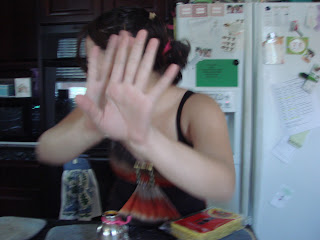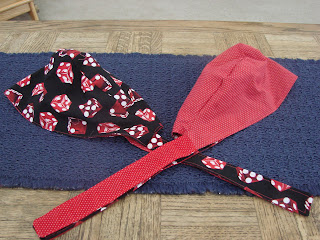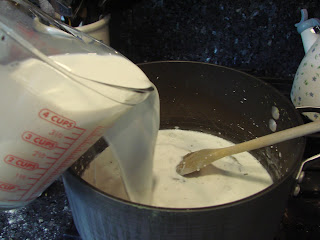Easy Egg Rolls
1 pound of ground beef
1 package (16 ounces) coleslaw mix (not the kind with dressing)
2 tablespoons soy sauce
1/2 teaspoon garlic powder
1/4 teaspoon ground ginger
onion powder to taste,
40 egg roll wrappers
1 tablespoon all purpose flour
Oil for frying
In a large skillet, cook the ground beef. Drain very well.
In a mixing bowl, combine coleslaw mix, soy sauce, ginger, garlic powder and onion powder.
Add the ground beef and mix well.
In a small bowl, mix the flour and enough water to make a paste. (I actually omitted this step, and used plain water.)
Working with one egg roll wrapper at a time, Place a heaping tablespoon of beef mixture in the center of the wrapper. Keep the other wrappers covered with a damp paper towel.
Fold the bottom corner over the filling:
Then the side corners into the center:
Moisten the top corner with your flour/water paste mixture, (or plain water), and roll up tightly:
Place on a parchment paper lined cookie sheet until all egg rolls are made.
Those are Brittany's fingers, so I figured she wanted to be included in this post. Here she is:
Whoops, guess I was wrong!
In an electric skillet, heat 1 inch of oil to 375 degrees. Fry egg rolls 3-5 minutes, or until golden brown. Serve with sweet and sour sauce, if desired. I actually cooked them in the oven the first time. Arrange on a cookie sheet, spray with non stick cooking spray, and bake at 375 degrees until golden brown. They were good that way too, but next time, if I have room on my stove, I will fry them.
This recipe made 40 egg rolls, which is way too many for us to eat at one meal. So, you guessed it, I froze them! After lining them up on cookie sheets, I stuck them in the freezer. Once they were solid, I removed them to a ziptop bag, and labeled them. This way, I can take out only what I need for a snack or a meal. All in all, this recipe took me about an hour to finish.
I can see that this recipe would be very versatile, as well. Next time, I will use ground pork, and possibly add some bean sprouts. You could vary the amounts of garlic, onion, and ginger powder you use. You could also substitute teriyaki or plum sauce for the soy sauce. Use this as a spring board....as an almost complete departure from the traditional egg roll, you could use ground pork, barbecue sauce, and coleslaw mix for a pulled pork sandwich type of experience. Experiment, I know I'm going to!


























































